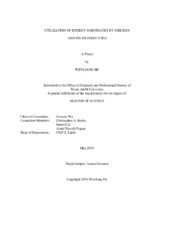| dc.description.abstract | Enterocytes, the major absorptive cells in small intestine, have high rates of growth and turnover at the early stage. These properties make the cells have a high demand for energy. An integrated knowledge on metabolic fates of diverse nutrients and their contributions to ATP production by enterocytes helps to improve the strategy for formulating balanced diets. Glutamate and glutamine are known to be major energy substrates for mammalian enterocytes, but little is known about metabolic fuels for post-hatching chicken enterocytes. In addition, there is a paucity of information about the metabolism of other amino acids and fatty acids in chicken or pig enterocytes.
In the present study, enterocytes isolated from 0- to 42-day-old chickens or 0- to 21-day-old piglets were used to determine the metabolic fates of amino acids, fatty acids and glucose. Enterocytes isolated from the jejunum of chickens or pigs were incubated at 40℃ or 37℃, respectively, for 30 min in Krebs-Henseleit bicarbonate buffer (pH 7.4) containing 5 mM D-glucose and one of the following: 0.5-5 mM L-[U-^14C]glutamate, 0.5-5 mM L-[U-^14C]glutamine, 0.5-5 mM L-[U-^14C]aspartate, 0.5-5 mM L-[U-^14C]alanine, 0.5-2 mM L-[U-^14C]palmitate, D-[U-^14C]glucose, 0.5-5 mM [U-^14C]propionate, or 0.5-5 mM [1-^14C]butyrate. At the end of the incubation, ^14CO2 produced from each ^14C-labeled substrate was collected for counting.
Rates of oxidation of each substrate by enterocytes from all age groups of chickens and pigs increased (P ˂ 0.01) progressively with increasing its extracellular concentrations. The rates of oxidation of glutamate by enterocytes from 0- to 41-day-old chickens were much greater (P ˂ 0.01) than those for the same concentrations of other substrates. Oxidation of glutamine, propionate, butyrate and palmitate by enterocytes of chickens was limited during their post-hatching growth. In contrast, the oxidation of glutamate, glutamine, aspartate, and glucose contributed to much more ATP production by enterocytes from 0- to 21-day-old piglets than any other substrates. Compared with 0-day-old pigs, the rates of oxidation of glutamate, aspartate, glutamine, alanine, and glucose by enterocytes from 21-day-old pigs decreased (P ˂ 0.01) markedly, without changes the rate of palmitate oxidation. Oxidation of alanine, propionate, and butyrate by enterocytes of piglets was limited during their postnatal growth.
Our results indicate that glutamate is the major metabolic fuel in enterocytes of 0- to 42-day-old chickens. However, amino acids (glutamate plus glutamine plus aspartate) are the major metabolic fuels in enterocytes of 0- to 21-day-old pigs. Because of limited uptake of arterial glutamate by enterocytes of chickens and pigs, dietary glutamate is essential to the integrity and function of their small intestines. | en |


